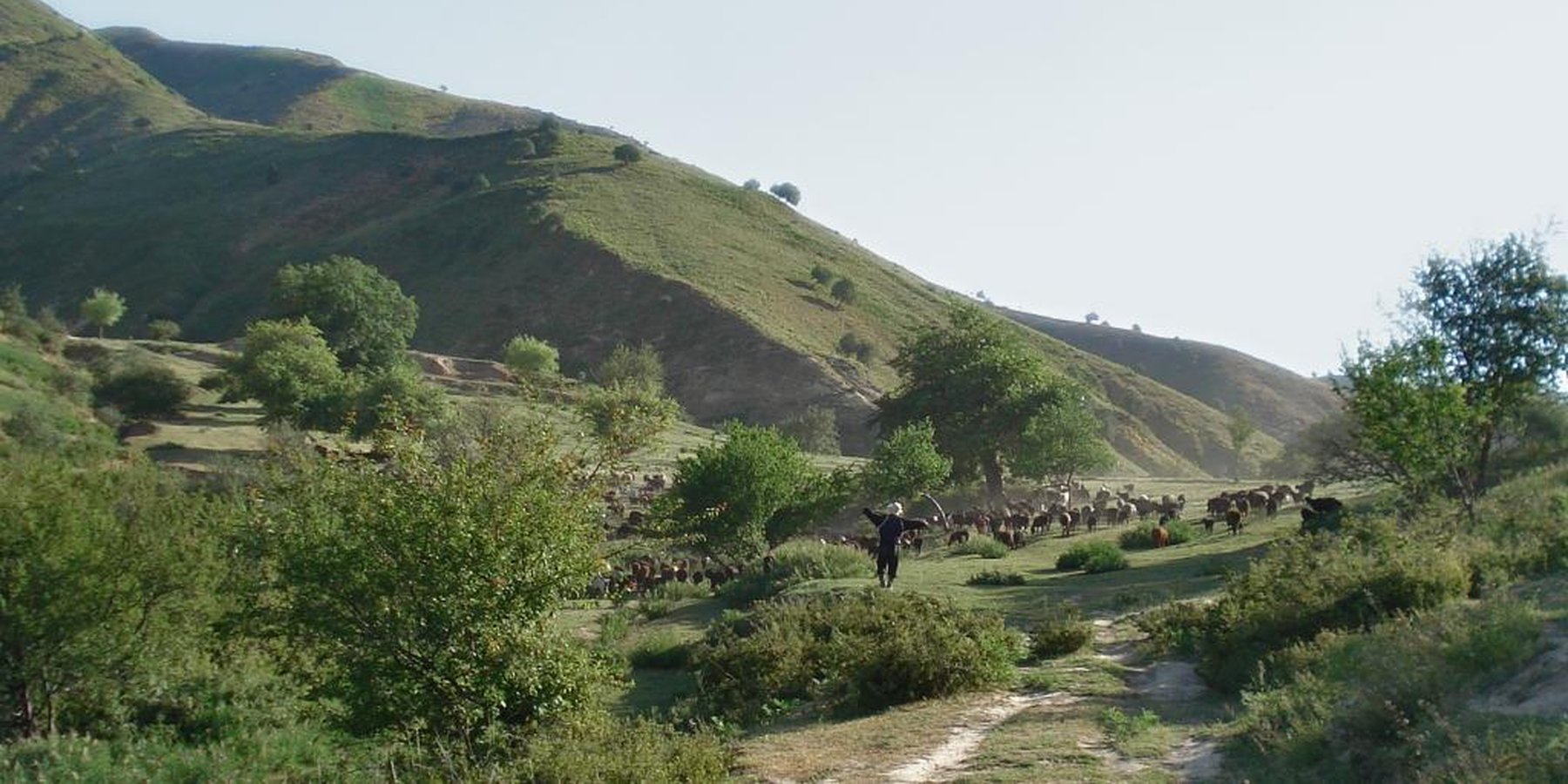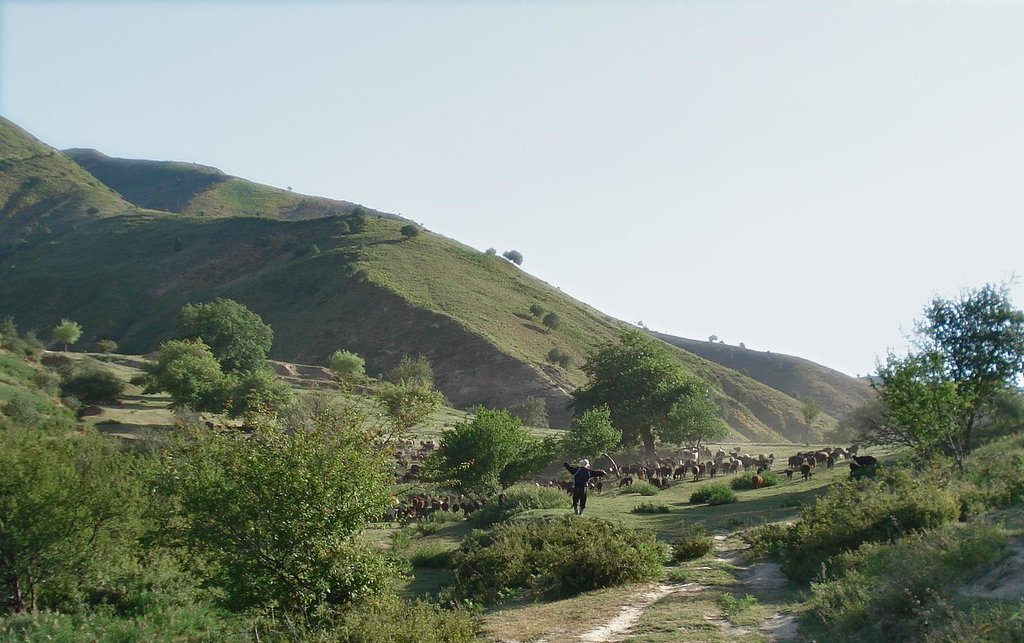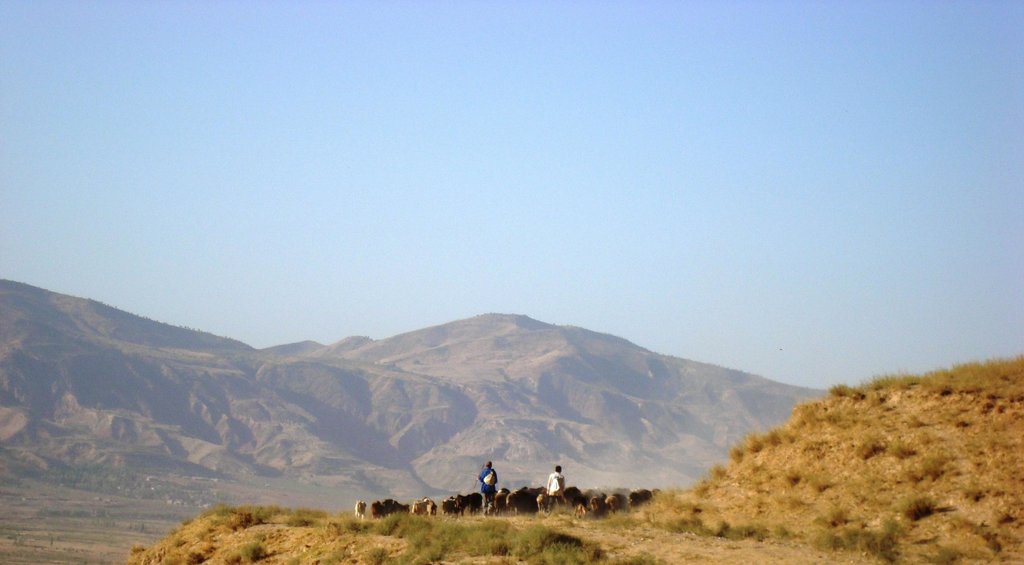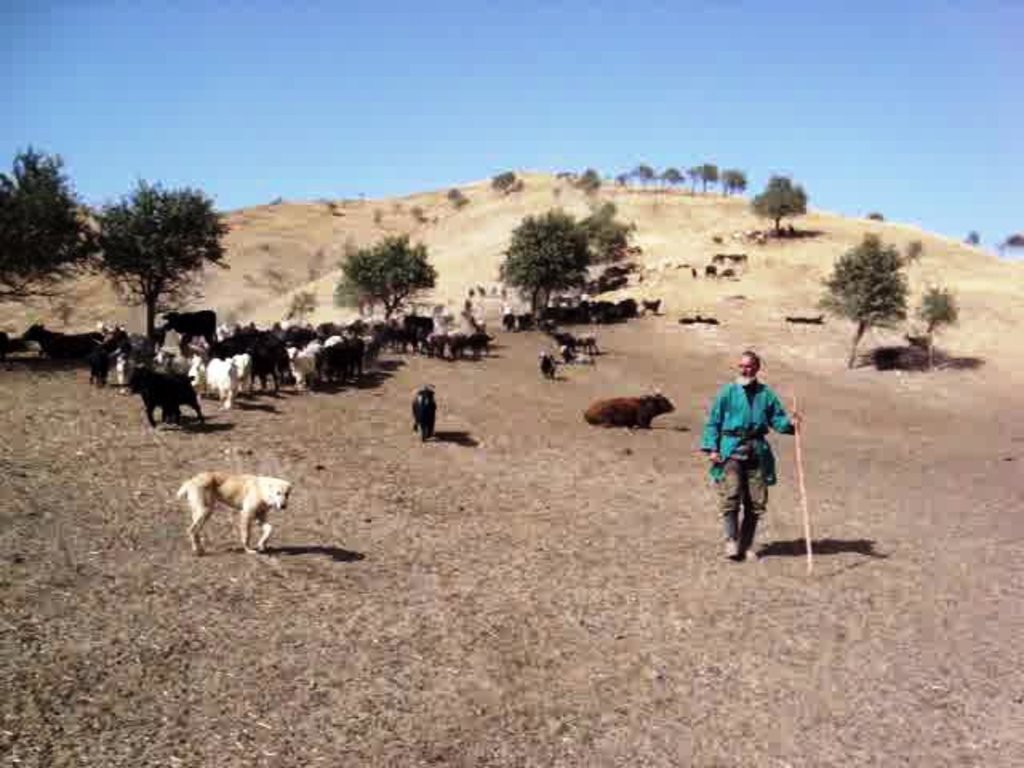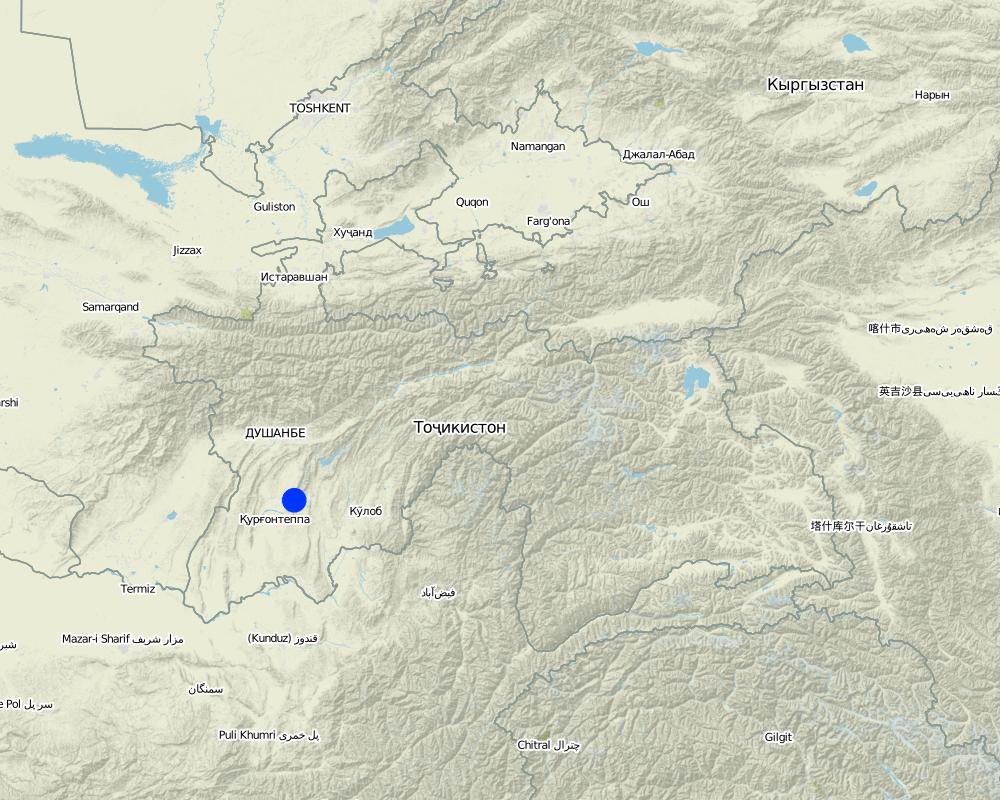Seminomadic individual herding [ប្រទេសតាហ្ស៊ីគីស្ថាន]
- ការបង្កើត៖
- បច្ចុប្បន្នភាព
- អ្នកចងក្រង៖ Christian Wirz
- អ្នកកែសម្រួល៖ –
- អ្នកត្រួតពិនិត្យ David Streiff
Chupon / Dajmardei Khaspi (professional herding)
approaches_2565 - ប្រទេសតាហ្ស៊ីគីស្ថាន
ពិនិត្យមើលគ្រប់ផ្នែក
ពង្រីកមើលទាំងអស់ បង្រួមទាំងអស់1. ព័ត៌មានទូទៅ
1.2 ព័ត៌មានលម្អិតពីបុគ្គលសំខាន់ៗ និងស្ថាប័នដែលចូលរួមក្នុងការវាយតម្លៃ និងចងក្រងឯកសារនៃវិធីសាស្ត្រផ្សព្វផ្សាយ
ឈ្មោះអង្គភាពមួយ (ច្រើន) ដែលបានចងក្រងឯកសារ/ វាយតម្លៃលើវិធីសាស្ត្រផ្សព្វផ្សាយ (បើទាក់ទង)
CDE Centre for Development and Environment (CDE Centre for Development and Environment) - ប្រទេសស្វ៊ីស1.3 លក្ខខណ្ឌទាក់ទងទៅនឹងការប្រើប្រាស់ទិន្នន័យដែលបានចងក្រងតាមរយៈវ៉ូខេត
តើពេលណាដែលទិន្នន័យបានចងក្រង (នៅទីវាល)?
15/08/2008
អ្នកចងក្រង និង(បុគ្គលសំខាន់ៗ)យល់ព្រមទទួលយកនូវលក្ខខណ្ឌនានាទាក់ទងទៅនឹងការប្រើប្រាស់ទិន្នន័យដែលបានចងក្រងតាមរយៈ វ៉ូខេត:
បាទ/ចា៎
1.4 ការយោងមួយ (ច្រើន) ទៅលើ (កម្រង) បញ្ជីសំណួរនៃបច្ចេកទេស SLM
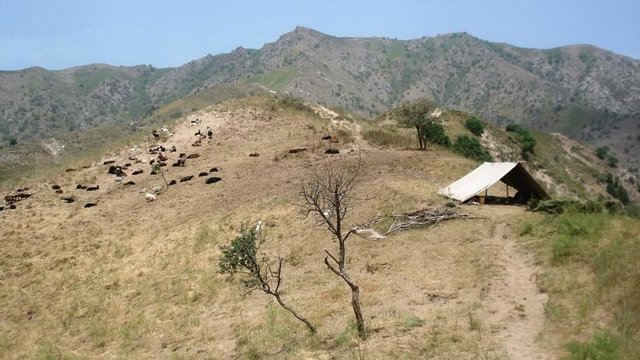
Daily and seasonal rotation on grassland [ប្រទេសតាហ្ស៊ីគីស្ថាន]
Extensive grazing of sheep and goats by the means of a precise rotational scheme
- អ្នកចងក្រង៖ Christian Wirz
2. ការពណ៌នាអំពីវិធីសាស្ត្រផ្សព្វផ្សាយ SLM
2.1 ពណ៌នាសង្ខេបខ្លីពីវិធីសាស្ត្រផ្សព្វផ្សាយ
Pasture management by a single herder, assisted either by an employee or by his own grandchildren, in collaboration with the habitants of the nearby village Karsang.
2.2 ពណ៌នាលម្អិតពិវិធីសាស្ត្រផ្សព្វផ្សាយ
ពណ៌នាលម្អិតពិវិធីសាស្ត្រផ្សព្វផ្សាយ:
Aims / objectives: The herder chooses his territory by the criteria of biomass, vegetation cover and availability of surface water. In his work he gives special attention to fattening the animals, to not losing any of them and to giving back the right animals to the right tenant at the end of the season. For him it is important to be sincere with the tenants and to pay for lost animals.
Methods: Every method applied serves the target of having an obeying herd. The herder works with lots of patience. In the first two weeks he pays very much attention to keeping the herd together, so the animals get used to each other. The rotational grazing scheme also fulfills the requirement of fattening the animals. Grazing the animals by night-time is a method to make the animals obey better. Part of the work is the daily control of the herd to identify sick animals and treat them.The animals are by the way not led by the herder, but rather accompanied by him.
Stages of implementation: After apprenticeship the herder is entrusted with animals from the village and with the generated income can then gradually build up his own herd.
Role of stakeholders: The herder is responsible for the relation with his animals, with the villagers and with the forest department (contract).
2.3 រូបភាពនៃវិធីសាស្ត្រផ្សព្វផ្សាយ
2.5 ប្រទេស/តំបន់/ទីតាំងកន្លែង ដែលវិធីសាស្ត្រផ្សព្វផ្សាយត្រូវបានអនុវត្តន៍
ប្រទេស:
ប្រទេសតាហ្ស៊ីគីស្ថាន
តំបន់/រដ្ឋ/ខេត្ត:
Region of Republican Subordination
បញ្ជាក់បន្ថែមពីលក្ខណៈនៃទីតាំង:
Faizabad
Map
×2.6 កាលបរិច្ឆេទនៃការចាប់ផ្តើម និងបញ្ចប់នៃវិធីសាស្រ្តផ្សព្វផ្សាយនេះ
សូមបញ្ជាក់ឆ្នាំដែលបានបង្កើតឡើង:
1987
2.7 ប្រភេទនៃវិធីសាស្ត្រផ្សព្វផ្សាយ
- ក្រុមប្រពៃណី/ក្រុមជនជាតិភាគតិច
2.8 គោលបំណង/ទិសដៅសំខាន់នៃវិធីសាស្ត្រផ្សព្វផ្សាយ
The Approach focused mainly on other activities than SLM (The focus of this approach is providing the own family with income and meat, by herding own and animals of other herders. It is very important for the herder to keep the animals healthy and to give them all back (the fattest possible) to their tenants.)
The herder's motivation to continue his father's work was that it enabled him to nourish his family. In his work he pays attention to fatten the animals enough to make them survive winter and to give them all back.
The SLM Approach addressed the following problems: The inhabitants of the village give the herder their animals because they know that the animals will be more healthy on the more natural pastures frequented by him compared with village pastures and because the animals get more reserves for winter-time. The herder claims that the animals need 50% less hay and fodder in winter than the animals grazed near the villages.
2.9 លក្ខខណ្ឌអនុញ្ញាត ឬរារាំងការអនុវត្តន៍បច្ចេកទេសដែលស្ថិតនៅក្រោមវិធីសាស្រ្តផ្សព្វផ្សាយ
សង្គម/វប្បធម៌/ និងតម្លៃនៃសាសនា
- រារាំង
Being unable to go to parties and weddings.
Treatment through the SLM Approach: As it is not a problem for the herder (but perhaps for his wife and family?) the problem is not tackled.
ភាពអាចរកបាននៃធនធានហិរញ្ញវត្ថុ និងសេវាកម្ម
- រារាំង
Paying for lost animals.
Treatment through the SLM Approach: As long as the herder can find the lost animal, even if it is dead, he will not have to pay for it.
បរិបទនៃស្ថាប័ន
- រារាំង
It is necessary to have good relations to obtain land from the forest administration.
Treatment through the SLM Approach: As M. worked for the forest department for many years, it was not a problem for him to lease land.
ក្របខណ្ឌច្បាប់ (សិទ្ធិកាន់កាប់ដីធ្លី កម្មសិទ្ធីប្រើប្រាស់ដីនិងទឹក)
- អំណោយផល
If tenure were more secure and land use free, M. would divide the rented land into pasture zone, orchard and cropland. This would ensure more self-sufficiency, but probably less income, because he could keep less animals on the reduced pasture area
- រារាំង
ផ្សេងៗ
- រារាំង
For M. the principal problem are bears (and wolves) killing animals.
Treatment through the SLM Approach: Since he is not allowed to have a rifle to kill wild animals he has to chase them away with his dogs. This means that in summer, when the bears descend to lower areas for fruit in the orchards, he often has to keep awake by night.
3. ការចូលរួម និងតួនាទីរបស់ភាគីពាក់ព័ន្ធ
3.1 អ្នកពាក់ព័ន្ធដែលបានចូលរួមក្នុងវិធីសាស្ត្រផ្សព្វផ្សាយ និងតួនាទីរបស់ពួកគេ
- អ្នកប្រើប្រាស់ដីក្នុងតំបន់/សហគមន៍
The herder himself is the protagonist. In some years he employed and educated young herders.
ប្រសិនមានភាគីពាក់ព័ន្ធច្រើនចូលរួមសូមចង្អុលបង្ហាញភ្នាក់ងារដែលនាំមុខគេ:
The herder himself implements the approach
3.2 ការចូលរួមរបស់អ្នកប្រើប្រាស់ដីក្នុងតំបន់/ សហគមន៍ក្នុងតំបន់ក្នុងដំណាក់កាលផ្សេងគ្នានៃវិធីសាស្រ្តផ្សព្វផ្សាយ
| ការចូលរួមរបស់អ្នកប្រើប្រាស់ដីក្នុងតំបន់/សហគមន៍ក្នុងតំបន់ | សូមបញ្ជាក់នរណាត្រូវបានចូលរួម ព្រមទាំងពណ៌នាសកម្មភាពទាំងនោះ | |
|---|---|---|
| ការចាប់ផ្តើម/ការលើកទឹកចិត្ត | គំនិតផ្តួចផ្តើមដោយខ្ឡួនឯង | Deciding to be a herder |
| ការរៀបចំផែនការ | គ្មាន | |
| ការអនុវត្តន៍ | គំនិតផ្តួចផ្តើមដោយខ្ឡួនឯង | Once M. knew how to treat the animals he could begin work with an own herd. |
| ការត្រួតពិនិត្យ និងវាយតម្លៃ | គ្មាន | |
| Research | គ្មាន |
3.4 ការសម្រេចចិត្តលើការជ្រើសរើសបច្ចេកទេស SLM
សូមបញ្ជាក់តើអ្នកណាជាអ្នកបានសម្រេចចិត្តក្នុងការជ្រើសរើសបច្ចេកទេសដើម្បីយកមកអនុវត្តន៍:
- អ្នកប្រើប្រាស់ដីដោយខ្លួនឯងផ្ទាល់ (គំនិតផ្តួចផ្តើមដោយខ្លួនឯង)
ចូរពន្យល់:
The herder learnt his profession during an apprenticeship of one year
Decisions on the method of implementing the SLM Technology were made by by land users* alone (self-initiative / bottom-up). M. learned all the technologies from his father, but says, that he only does his job half as well as his father.
4. ជំនួយបច្ចេកទេស ការកសាងសមត្ថភាព និងការគ្រប់គ្រងចំណេះដឹង
4.1 ការកសាងសមត្ថភាព/ បណ្តុះបណ្តាល
តើវគ្គបណ្តុះបណ្តាលបានផ្តល់ឱ្យអ្នកប្រើប្រាស់ដី/អ្នកពាក់ព័ន្ធផ្សេងៗទៀតដែរឬទេ?
បាទ/ចា៎
សូមបញ្ជាក់តើអ្នកណាត្រូវបានបណ្តុះបណ្តាល:
- បុគ្គលិកចុះទីវាល/អ្នកផ្តល់ប្រឹក្សាយោបល់
ប្រសិនទាក់ទង សូមបញ្ជាក់ ភេទ អាយុ ស្ថានភាពគ្រួសារ ជនជាតិដើមភាគតិច។ល។:
Young men and boys.
ទម្រង់នៃការបណ្តុះបណ្តាល:
- អនុវត្តន៍ជាមួយការងារ
ប្រធានបទបណ្តុះបណ្តាល:
Teaching of herding method: He tells his assistants not to beat the animals, not to shout at them, to treat animals fairly so they obey and to nourish them sufficiently so they don't walk away by night.
4.2 សេវាផ្តល់ប្រឹក្សាយោបល់
តើអ្នកប្រើប្រាស់ដីបានទទួលនូវសេវាផ្តល់ប្រឹក្សាដែរ ឬទេ?
ទេ
4.4 ការត្រួតពិនិត្យ និងវាយតម្លៃ
មតិយោបល់:
There were no changes in the Approach as a result of monitoring and evaluation: None
There were no changes in the Technology as a result of monitoring and evaluation: None
5. ថវិកា និងសម្ភារៈឧបត្ថម្ភពីខាងក្រៅ
5.1 ថវិកាប្រចាំឆ្នាំសម្រាប់ផ្សព្វផ្សាយ SLM
ប្រសិនបើចំនួនពិតប្រាកដនៃថវិកាប្រចាំឆ្នាំមិនត្រូវបានដឹងច្បាស់ សូមប្រាប់ពីចន្លោះនៃថវិកានោះ:
- < 2,000
មតិយោបល់ (ឧ. ប្រភពសំខាន់នៃមូលនិធិ/ម្ចាស់ជំនួយចំបង):
Approach costs were met by the following donors: local community / land user(s) (All costs): 100.0%
5.2 ការគាំទ្រផ្នែកហិរញ្ញវត្ថុ / សម្ភារៈដែលបានផ្តល់ទៅឱ្យអ្នកប្រើប្រាស់ដី
តើអ្នកប្រើប្រាស់ដីបានទទួលការគាំទ្រផ្នែកហិរញ្ញវត្ថ/សម្ភារៈសម្រាប់ការអនុវត្តន៍បច្ចេកទេសដែរឬទេ:
ទេ
5.3 សូមបញ្ជាក់ពីធាតុចូលត្រូវបានផ្តល់បដិភាគ (រួមទាំងកម្លាំងពលកម្ម)
ប្រសិនបើកម្លាំងពលកម្មធ្វើដោយអ្នកប្រើប្រាស់ដី តើវាជាធាតុចូលដ៏សំខាន់មួយដែរ ឬទេ:
- ធ្វើការងារប្តូរជាអាហារ
មតិយោបល់:
Also paid in cash: Whereas his grandsons help him and get food therefore, the herder sometimes employs assistants who are paid.
5.4 ឥណទាន
តើឥណទានដែលបានផ្តល់នៅក្រោមវិធីសាស្ត្រផ្សព្វផ្សាយសម្រាប់សកម្មភាព SLM នេះយ៉ាងដូចម្តេច?
ទេ
6. ការវិភាគរកផលប៉ះពាល់ និងសេចក្តីសន្និដ្ឋាន
6.1 ផលប៉ះពាល់នៃវិធីសាស្ត្រផ្សព្វផ្សាយ
តើវិធីសាស្ត្រផ្សព្វផ្សាយជួយអ្នកប្រើប្រាស់ដីដើម្បីអនុវត្តន៍ និងថែទាំបច្ចេកទេស SLM?
- ទេ
- បាទ/ច៎ា បន្តិចបន្តួច
- បាទ/ច៎ា ជាមធ្យម
- បាទ/ច៎ា បានខ្លាំង
More biodiversity, less fertility decline, less cover reduction (compared to the grazing method used near the villages)
តើវិធីសាស្ត្រផ្សព្វផ្សាយនេះផ្តល់សិទ្ធិអំណាចដល់សង្គមនិងសេដ្ឋកិច្ចដែលក្រុមមិនទទួលបានផលប្រយោជន៍?
- ទេ
- បាទ/ច៎ា បន្តិចបន្តួច
- បាទ/ច៎ា ជាមធ្យម
- បាទ/ច៎ា បានខ្លាំង
Did other land users / projects adopt the Approach?
- ទេ
- បាទ/ច៎ា បន្តិចបន្តួច
- បាទ/ច៎ា ជាមធ្យម
- បាទ/ច៎ា បានខ្លាំង
Young men herding in Faizabad area, one of them only a few ridges in the east of M.
Did the Approach lead to improved livelihoods / human well-being?
- ទេ
- បាទ/ច៎ា បន្តិចបន្តួច
- បាទ/ច៎ា ជាមធ្យម
- បាទ/ច៎ា បានខ្លាំង
Whereas in the villages every family has to send someone as a herder once per month, M. earns money for his job and breeds his own animals. On the other hand the family structure is disrupted by the c
Did the Approach help to alleviate poverty?
- ទេ
- បាទ/ច៎ា បន្តិចបន្តួច
- បាទ/ច៎ា ជាមធ្យម
- បាទ/ច៎ា បានខ្លាំង
In finacial terms, it did (by generating income), But in terms of education, it did not help.
6.2 ការលើកទឹកចិត្តចម្បងៗរបស់អ្នកប្រើប្រាស់ដីសម្រាប់ការអនុវត្តបច្ចេកទេស SLM
- បង្កើនផលិតកម្ម
Animals get fatter than on the common pastures
- ពង្រឹងស្មារតីផ្នែកបរិស្ថាន
The herder somehow has a consciousness of only taking from nature for what he has paid
6.3 សកម្មភាពផ្សព្វផ្សាយដែលប្រកបដោយចីរភាព
តើអ្នកប្រើប្រាស់ដីអាចធ្វើឱ្យមានចីរភាពនូវអ្វីដែលត្រូវបានអនុវត្តន៍តាមរយៈវិធីសាស្ត្រផ្សព្វផ្សាយដែរឬទេ(ដោយពុំមានការគាំទ្រពីអ្នកខាងក្រៅ)?
- បាទ/ចា៎
ប្រសិនបាទ/ច៎ា សូមរៀបរាប់ថាធ្វើយ៉ាងម៉េច:
The herder intends to continue his work as long as physically possible. He though wants to take less animals in the following year and instead more cows and less sheep and goats. He says that cows are easier to keep and in addition, he is paid four times more for a cow than for a sheep or a goat.
6.4 ភាពខ្លាំង/ គុណសម្បត្តិនៃវិធីសាស្ត្រផ្សព្វផ្សាយ
| ភាពខ្លាំង/ គុណសម្បត្តិ/ ឱកាស ទស្សនៈរបស់អ្នកប្រើប្រាស់ដី |
|---|
| Each tenant has animals with their own comportment. M. only has to deal with a little number of tenants (and thus animal comportments), whereas the village herds are composed by animals of much more tenants. |
| animals can get used to each other. The composition of the big village herd is not always the same. |
| The herder is always the same and treats the animals fairly: he leads the animals slowly and doesn't shout at them or beat them. |
| ភាពខ្លាំង/ គុណសម្បត្តិ/ ឱកាស ទស្សនៈរបស់បុគ្គលសំខាន់ៗ |
|---|
| With around 600-700$ per season, the work as a professional herder is quite well-paid (for rural areas). (How to sustain/ enhance this strength: As soon as work in the foreigner (especially Russia) becomes scarce, herding will be more attractive again.) |
| For people with a tight relationship to nature and god (in the case of M.) this area is a good place, since remote. (How to sustain/ enhance this strength: There will probably continue to be religious, nature-bound young people.) |
6.5 ភាពខ្សោយ/ គុណវិបត្តិនៃវិធីសាស្ត្រ និងរកដំណោះស្រាយ
| ភាពខ្សោយ/ គុណវិបត្តិ/ ហានិភ័យ ទស្សនៈរបស់អ្នកប្រើប្រាស់ដី | តើបច្ចេកទេសទាំងនោះបានដោះស្រាយបញ្ហាដូចម្តេច? |
|---|---|
| The trees damaged by the animals are a problem from the herder's point of view. | He sees the main problem in the past civil war, when lots of trees were chopped illegally. He says that tree-planting would not be a solution, because then grazing would not be possible anymore either. |
| ភាពខ្សោយ/ គុណវិបត្តិ/ ហានិភ័យក្នុងទស្សនៈរបស់បុគ្គលសំខាន់ៗ | តើបច្ចេកទេសទាំងនោះបានដោះស្រាយបញ្ហាដូចម្តេច? |
|---|---|
| The way of living is not modern in the young peoples' eyes: They prefer social and urban to rural, solitary life. | As long as poverty predominates in the villages and cities cannot offer enough jobs to young people, agriculture and herding will stay interesting. Though, new (old) forms of herding might appear, such as herding in groups. |
| Night grazing makes sheep eat impalatable (poisonous) plants and than become sick (according to a specialist from CARITAS). | Training and workshops could be a platform for the discussion of such critical aspects. |
ការតភ្ជាប់ និងម៉ូឌុល
ពង្រីកមើលទាំងអស់ បង្រួមទាំងអស់ការតភ្ជាប់

Daily and seasonal rotation on grassland [ប្រទេសតាហ្ស៊ីគីស្ថាន]
Extensive grazing of sheep and goats by the means of a precise rotational scheme
- អ្នកចងក្រង៖ Christian Wirz
ម៉ូឌុល
គ្មានម៉ូឌុល


